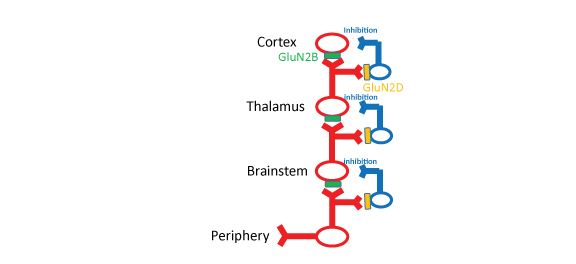Opposing role of NMDA receptor GluN2B and GluN2D in somatosensory development and maturation
Research Press Release | October 22, 2014
-
 Fig. 1. Whisker-related somatosensory map formation in rodent brains. Whiskers are tactile hairs on the snout, and sensory information from individual whiskers is conveyed to specific synaptic clusters formed at each somatosensory relay station.
Fig. 1. Whisker-related somatosensory map formation in rodent brains. Whiskers are tactile hairs on the snout, and sensory information from individual whiskers is conveyed to specific synaptic clusters formed at each somatosensory relay station. -
 Fig. 2. Developmental appearance of somatosensory map is retarded in mutant mice defective in GluN2B subunit of NMDA receptors, whereas it is advanced in mutant mice defective in GluN2D subunit.
Fig. 2. Developmental appearance of somatosensory map is retarded in mutant mice defective in GluN2B subunit of NMDA receptors, whereas it is advanced in mutant mice defective in GluN2D subunit. -
 Fig. 3. GluN2B is selectively expressed at synapses of glutamatergic projection neurons and facilitates refinement of the ascending pathway synapses directly, whereas GluN2D is expressed at synapses of GABAergic interneurons and delays it indirectly.
Fig. 3. GluN2B is selectively expressed at synapses of glutamatergic projection neurons and facilitates refinement of the ascending pathway synapses directly, whereas GluN2D is expressed at synapses of GABAergic interneurons and delays it indirectly.
| Press Release | ||
|---|---|---|
| Key Points |
1. Of the two NMDA-type glutamate receptor subunits expressed in developing brains, we discovered that GluN2B subunit facilitates synapse refinement along the somatosensory pathway, whereas GluN2D retards it in a counteractive manner. 2. GluN2B is predominantly expressed at synapses on glutamatergic projection neurons connecting from the periphery to the somatosensory cortex, while GluN2D is selective at synapses on GABAergic local interneurons at individual somatosensory stations. 3. Based on the distinct functions and expressions, the two NMDA receptor subunits control the maturation of the somatosensory system through coordinated promotion of excitatory and inhibitory circuit development. |
|
| Overview |
During early postnatal days called the critical period, synaptic circuits are effectively refined in activity- and experience-dependent manners according to environments and sensory stimuli given to immature animals and human individuals. Excitatory transmitter glutamate is involved in this synapse refinement during the critical period, and NMDA-type glutamate receptors play a critical role in this refinement. In neonatal brains, two NMDA receptor subunits GluN2B and GluN2D are expressed, but it remains uncertain whether their functional roles are synergistic or antagonistic. In the present study, we pursued this issue by examining their functions and expressions in the somatosensory system, which transmits and processes sensory information captured in the skin, hairs, and mucous membrane. By comparing developmental profiles of somatosensory maps corresponding to whiskers on the snout in GluN2B-deficient and GluN2D deficient mice, we found that GluN2B promotes synapse refinement and maturation, but GluN2D retards them. To understand the distinct and counteractive developmental actions, we further examined synaptic expression and found that GluN2B is predominantly expressed at synapses on glutamatergic projection neurons connecting from the periphery to the somatosensory cortex, while GluN2D is selective at synapses on GABAergic local interneurons at individual somatosensory stations. These findings suggest that GluN2B expressed along the major ascending pathway directly accelerates somatosensory development and maturation, while GluN2D selective at local inhibitory stations brake them indirectly. Through the push-and-pull mechanisms, development and maturation of synaptic circuits appear to be controlled coordinately. This study was published in Journal of Neuroscience (34:11534-11548, 2014), in which it was selected for This Week in The Journal. Moreover, this study was selected for Editor’s Choice in Science (345:1575, 2014). This investigation was supported through Grant-in-Aid for Scientific Research provided by the Ministry of Education, Culture, Sports, Science and Technology, the Japanese Government, and also through CREST provided by the Japan Science and Technology Agency. |
|
| Inquiries |
Masahiko Watanabe, Professor, Department of Anatomy, Graduate School of Medicine, Hokkaido University TEL: +81-11-706-5032 FAX: +81-11-706-5031 E-mail: watamasa@med.hokudai.ac.jp |
|
|
Japanese Link |
発達期の2つの NMDA 型グルタミン酸受容体サブユニットはシナプス回路の発達と成熟を相反的に制御する | |
| Publications | Opposing Role of NMDA Receptor GluN2B and GluN2D in Somatosensory Development and Maturation (The Journal of Neuroscience, 2014.8.27) | |
